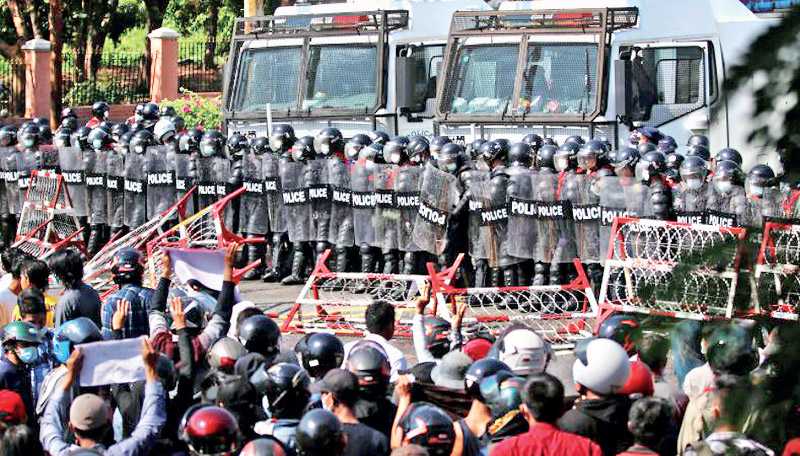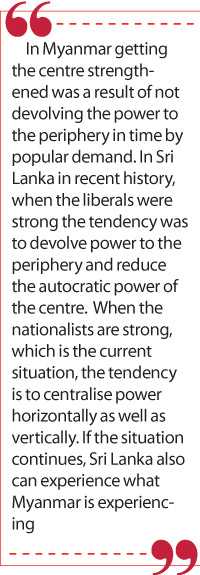Sunday Apr 13, 2025
Sunday Apr 13, 2025
Thursday, 8 April 2021 00:00 - - {{hitsCtrl.values.hits}}

Myanmar is in the illegal and illegitimate hands of the Military
 Myanmar is in the headlines of world news these days, not for good reasons but for very bad reasons. There was a coup and the Military took over the Government by force on 1 February. People are protesting and the Military is shooting at unarmed demonstrators. Day by day there are more deaths reported as protests continue across Myanmar.
Myanmar is in the headlines of world news these days, not for good reasons but for very bad reasons. There was a coup and the Military took over the Government by force on 1 February. People are protesting and the Military is shooting at unarmed demonstrators. Day by day there are more deaths reported as protests continue across Myanmar.
Mahn Win Khaing Than, the Acting Leader of Myanmar’s parallel civilian Government, which is called Committee Representing Pyidaungsu Hluttaw (both Houses of the National Assembly) CRPH, appointed by legislators who were removed following a power grab by the military in February, has promised to pursue a “revolution” to overturn the Military Government. He is in hiding along with most senior officials from the governing National League for Democracy Party (NLD) and addressed the public via Facebook.
The Military of Myanmar is ruthless, cannot be trusted and is unacceptable as a political authority except for the persons like Dinesh Gunawardena who invited the Foreign Minister of Military Junta of Myanmar to the BIMSTEC Summit to be held in Sri Lanka. It is clearly visible that the Military Junta does not represent the views of the people of Myanmar from whom the sovereign power of the Union is derived, according to the Military facilitated 2008 constitution of Myanmar (Article 4). It is not a kingdom of the Military. Therefore, this invitation is questionable.
In July 1962 there were riots at the University of Rangoon and the troops were sent to restore order. Military dictator Ne Win said, “If these disturbances were made to challenge us, I have to declare that we will fight sword with sword and spear with spear.” The Military fired on protesters and destroyed the Student Union building. After the uprising started on 8 August 1988, the same Ne Win said, “Army would have to be called and I would like to declare from here that if the Army shoots it has no tradition of shooting into the air. It would shoot straight to hit.” It was reported that the death toll was around 3,000.
China and Russia firmly back the current Military Junta at international forums.
Myanmar
The main ethnic group in Myanmar is Bamar (Burmans) (68%). Others are Shan (9%), Karen (7%), Rakhine (1.7%), Chinese (2.5%), Mon (2%), Kachin (1.5%), Indians (1.25%) Kayah (1.83%) Chin and several other groups. The State recognises 135 different ethnic groups. It is the position of the Myanmar that the Muslim community of Rohingya which occupies northern Rakhine area bordering to Bangladesh are the illegal immigrants from Bangladesh. Buddhists accounts for 88% of the population, 6% Christians and 4% belongs to Islam.
Prior to independence from the British, in order to achieve independence speedily, Aung San, Head of the Transitional Government, signed an agreement with the minority ethnic groups in February 1947 which was called the Panglong Agreement where full autonomy in internal administration of the Frontier Areas of the ethnic minorities was promised by the Government in principle.
Frontier Areas means the areas of the ethnic minorities which did not come under the Burmans in the history. Therefore, there was a historical reason for their request although all of them got together to get independence from the British. Aung San was assassinated in July 1947 prior to the independence and the agreement was not honoured by the successive governments dominated by Burmans who were not in favour of granting more autonomy to the Regions. As a result, ethnic clashes started.
Soon after independence during the time of U Nu, the first Prime Minister of Myanmar, there was an uprising of the communists which was suppressed. There was a division of the ruling party, Anti-Fascist People’s Freedom League and U Nu survived narrowly at a no confidence motion against him. With the irrupting ethnic clashes, he invited Ne Win, a Burman Military officer to take over the government temporarily in 1958 overlooking the Chief of Staff Smith Dun, a Karen. Ne Win handed back power in 1960 but in 1962 he took back power forcibly. It was the beginning of a long period until a civilian government led by Aung San Suu Kyi took power in 2015.
Ethnic clashes throughout the country needed a strong government in the centre which paved the way for the military regime. Once obtained power military strengthened its position in governance. However, the ethnic clashes continued. Different ethnicities are having their own militias. They feel that they are insecure without these militias. In addition to that there are other militias as well.
Some of the militias work in collaboration with the Military of Myanmar. Some of the militias engage in direct clashes with the Military which is called Tatmadaw. There are four types of militias in Myanmar. Those are Tatmadaw-integrated militias, Tatmadaw non-integrated militias, Tatmadaw-operated community militias and Ethnic Armed Organization (EAO) militias. Some of these militias are engaged in illegal activities such as the drug business. It was said that these militias occupy around one third of the land of Myanmar. (Militias in Myanmar – John Buchanan)
Although it tried to engage in peace negotiations with the various ethnic groups, the Military disagreed with the main request of the ethnic groups, a federal solution.
In Myanmar the majority is against sharing power. At a survey conducted under the supervision of the International Republican Institute, USA in 2019 following question was asked from the participants: “Do you support giving the States/Regions more autonomy and power so that they can make decisions for themselves, or do you think that all power and decisions should be centralised and made by the Union Government?” A total of 70% of the participants said that they were for centralisation and 28% said that they were for decentralisation; 8% was undecided; 53% preferred the regional Chief Ministers be appointed by the Union Government; 39% preferred that they be elected by the regions. Out of the participants 70% were the majority Burmans. (Public Opinion Survey Myanmar – 2019 – Centre for Insights in Survey Research)
The situation did not change significantly even after Suu Kyi came to power in 2015. Suu Kyi’s stand on Rohingya Muslims is well known. Gambia filed a case against Myanmar before the International Court of Justice (ICJ) on the allegation of genocide of Rohingyas. She represented the country and argued the case. Suu Kyi has reached out to the ethnic minority political parties to discuss improving relations during her tenure. Several of the parties accepted her offer, but several others remain sceptical, given her perceived disregard of minority concerns over the last five years.
However, NLD tried to change the constitution introduced by the Military in 2008, where the Military has 25% of the seats of both the Houses and the Constitution can be amended only with more than 75% approval of the House of Representatives. In addition to that a referendum is needed to amend certain articles (Article 436). NLD proposed to amend the Constitution in 2020; to give more powers to State and Regional legislatures by amending articles 188,196,198(b) and 198(d); to restrict the interference for the centre in periphery by amending articles 225 and 226; to give more power to the Regions and States in appointing the Chief Minister, appointing and termination of the Ministers to the Regions and States by amending articles 261, 262 and 264. The amendments were not approved since the Military did not support them.
Therefore, the NLD was more responsive to the ethnic issue compared to the Military. This was proved in the recent general elections which were nullified by the Military which was held on 8 November 2020. The House of Nationalities and the House of Representatives are the two Houses of the National Assembly of Myanmar. NLD lead by Suu Kyi won the House of Nationalities with 61.6% and the House of Representatives with 58.6% out of the total number of seats counting the allocated seats to the Military with the total. In both houses NLD won the majority covering the areas of all the States and Regions except for Rakhine and Shan States. NLD lost these States in both houses.
Elections of State and Regional Houses also were held and NLD won 56.9% of seats out of the total including 25% allocation to the Military. In addition to that there were 29 Ministers of Ethnic Affairs elected to State and Regional houses and 79% of them were from NLD. The elections were cancelled due to insurgency of 3.1%, 3.4% and 5.5% of the seats of House of Nationalities, House of Representatives and State and Regional Houses respectively.
Therefore, the victory for NLD was a landslide victory where they have increased the number of seats in both Houses in the National Assembly and State and Regional Houses compared to the general election held in 2015. Election monitors found that the election results were credible and reflecting the will of the majority of voters.
The people of Myanmar enjoyed the taste of freedom during the period NLD was in power. Hence, they will continue to agitate against the Military rule. If the regional ethnic groups and their militias can support the people, the situation would be difficult for the Military. For that the majority Burmans should forgo their interest in a centralised state. Hence the problem is coming to the point where the whole issue started. At the beginning it was independence from the British Empire and now it is independence from the Military.
Therefore, not solving the ethnic problem in Myanmar came back, destroying the freedom of the very people who oppose the devolution of power by way of an autocratic rule in the centre.
 Sri Lanka
Sri Lanka
The situation of Sri Lanka is a mild form of the situation in Myanmar. The core problem of the country is ethnic issue which paved the way for the 30-year-long internal conflict. Majority Sinhalese do not like to devolve power to the periphery. Several attempts were made by different political leaders to devolve power, but all failed. This resulted in the armed internal conflict and during the conflict with the influence of India, the 13th Amendment to the Constitution was brought in as a solution. However, the militants did not accept it and finally they were defeated in war.
The previous Government (2015-2019) started reforms based on popular demand and a democratic space for the people was created. The power of the president was reduced and that of the Parliament was strengthened by the 19th Amendment to the Constitution. The Government was in the process of preparation of a new constitution on one hand to convert the governance structure to a Westminster system once again and on the other hand to give more power to the Provincial Councils.
After the Easter Sunday attacks, popular thinking changed. There were demands that the post of the president should be strengthened, and this was done with the 20th Amendment to the Constitution and associated autocratic moves by the Government which were highlighted in the recent United Nations Human Rights Commission (UNHRC) resolution 46/1 as well.
Now there are demands that the limited powers given to the provinces also should be reduced. It is difficult to implement it mainly due to the opposition of India. However, the people who are used to the expanded democratic space during the previous regime cannot be suppressed easily by the strengthened centralised power of the president. China and Russia back Sri Lanka against international pressure.
Myanmar and Sri Lanka
Myanmar became independent on 4 January 1948 and Sri Lanka became independent one month later, on 4 February 1948.
The majority of both the countries, Burmans and Sinhalese, oppose federal constitutions. In Myanmar they use the term Union and in Sri Lanka they use the term Unitary State. All of them oppose even the word ‘Federal’.
Burmans and Sinhalese are mainly Buddhists. The divisions in both countries are mainly based on ethnicity and to a lesser extent on the religion. In Myanmar there are conflicts among Buddhist ethnic groups as well, which is not the case in Sri Lanka and therefore Sinhala Buddhists are a cohesive group.
In Myanmar getting the centre strengthened was a result of not devolving the power to the periphery in time by popular demand. In Sri Lanka in recent history, when the liberals were strong the tendency was to devolve power to the periphery and reduce the autocratic power of the centre. When the nationalists are strong, which is the current situation, the tendency is to centralise power horizontally as well as vertically. If the situation continues, Sri Lanka also can experience what Myanmar is experiencing.
Democratic states with devolved power are not weak states. Strength comes with unity and not with divisions.
In Myanmar it is difficult for the Junta to control the situation although they are killing innocent people left and right since people know what freedom was during the NLD regime. In Sri Lanka the image of the President who was feared very much before he came to power was reduced in line with the democratic freedom people enjoyed during the previous regime.
Myanmar and Sri Lanka were reported to ICJ and UNHRC respectively about their treatment of ethnic minorities. Therefore, the situation of both countries in this respect is internationalised. China and Russia are backing the regimes of both the countries when international pressure comes.
Myanmar is in the illegal and illegitimate hands of the Military. The world should move forward in the direction of recognising the parallel Civilian Government, the Committee Representing Pyidaungsu Hluttaw. The Special Rapporteur on the situation of Human Rights in Myanmar Thomas Andrews said that Myanmar need the help of the international community and they need that help now.
(Some of the information was gathered from Wikipedia.)
Discover Kapruka, the leading online shopping platform in Sri Lanka, where you can conveniently send Gifts and Flowers to your loved ones for any event including Valentine ’s Day. Explore a wide range of popular Shopping Categories on Kapruka, including Toys, Groceries, Electronics, Birthday Cakes, Fruits, Chocolates, Flower Bouquets, Clothing, Watches, Lingerie, Gift Sets and Jewellery. Also if you’re interested in selling with Kapruka, Partner Central by Kapruka is the best solution to start with. Moreover, through Kapruka Global Shop, you can also enjoy the convenience of purchasing products from renowned platforms like Amazon and eBay and have them delivered to Sri Lanka.
Discover Kapruka, the leading online shopping platform in Sri Lanka, where you can conveniently send Gifts and Flowers to your loved ones for any event including Valentine ’s Day. Explore a wide range of popular Shopping Categories on Kapruka, including Toys, Groceries, Electronics, Birthday Cakes, Fruits, Chocolates, Flower Bouquets, Clothing, Watches, Lingerie, Gift Sets and Jewellery. Also if you’re interested in selling with Kapruka, Partner Central by Kapruka is the best solution to start with. Moreover, through Kapruka Global Shop, you can also enjoy the convenience of purchasing products from renowned platforms like Amazon and eBay and have them delivered to Sri Lanka.